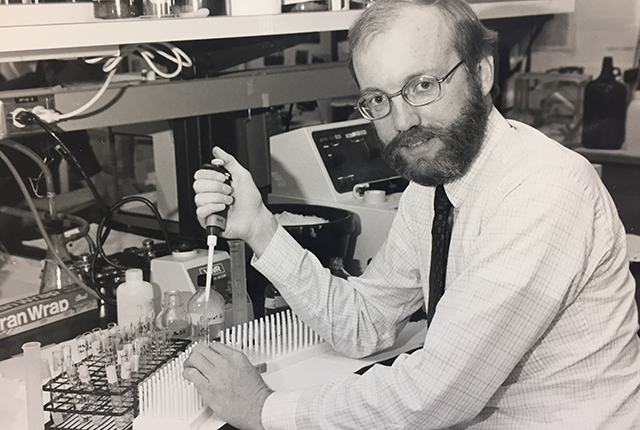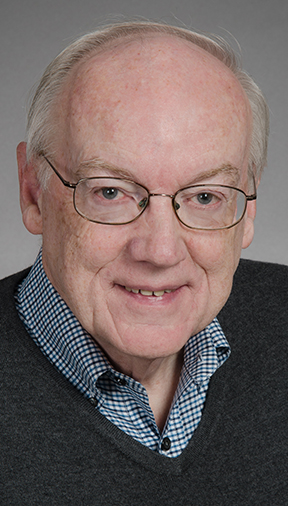
Remembering Bill Catterall, ion channel research pioneer
The scientist made many major discoveries on the tiny pores in living cells that generate electrical signals.Media Contact: Susan Gregg - 206-390-3226, sghanson@uw.edu

William A. “Bill” Catterall, a leading figure in studies of electrical signals in living cells, died Feb. 28 at age 77.
He was a professor and former chair of the Department of Pharmacology at the University of Washington School of Medicine in Seattle. His sudden passing occurred while he was in the Philippines attending an international calcium ion channel conference, where he was among the speakers.
As news of his passing spread, social media filled with former students and scientific colleagues around the world remembering Catterall as an excellent teacher, a collegial individual and a giant in his field.
Catterall is credited for discovering the voltage-gated sodium channel and calcium channels. These tiny pores in cell membranes are gatekeepers for the flow of charged particles. Different channels exist for different ions. They produce electric signals for brain, nerve, heart, and muscle cells to rapidly send information.
Such signals are essential to thinking, responding quickly, keeping the heart beating, contracting muscles, and for coordinating many other physiological actions, including learning and memory.

Catterall’s continued studies of these channels, at the molecular and atomic levels, with UW Medicine colleague biophysicist Bertil Hille, structural biologist Ning Zheng, and many others revealed in detail how they work.
His work on ion channels, in addition to establishing their essential normal functions, was important to improve the understanding of how certain drugs act as therapeutics for epilepsy, heart rhythm problems, high blood pressure, autism and other conditions related to faulty electrical signaling.
These findings suggest ideas for the development of targeted new drugs for a variety of heart, brain, and neuromuscular disorders, as well as for anesthetics and pain medications. Catterall also studied the deleterious ion-channel effects of neurotoxins, particularly those in venomous animals like tarantulas. He remained active in research until his passing.
Catterall’s team determined the structures of the sodium and calcium channels at an atomic resolution using X-ray crystallography and cryo-electron microscopy, which also provided insights to their activation, conduction of ions, and inactivation. He was also able to image, at the atomic level, how local anesthetics, heart anti-arrhythmia drugs and calcium-channel-blocker drugs bind to their target ion channel.
His prolific research group also studied the regulation of calcium channels in the heart in the fight-or-flight response and in heart failure. They also developed laboratory models of Dravet syndrome, a devastating childhood epilepsy disorder caused by sodium ion channel mutations. He also investigated the difficulty in titrating certain autism treatments to try to manage seizures as well as behavioral symptoms.
Alongside his many important scientific achievements, Catterall was highly regarded as a mentor. He cofounded the undergraduate degree in neurosciences and trained numerous graduate and postdoctoral students in pharmacology. He also generously shared his expertise in consultation with colleagues at the UW and globally.
“Bill was a titan of the field of ion channel physiology and a hugely influential force in the world of pharmacology,” said John D. Scott, the Edwin G. Krebs-Speights Professor of Cell Signaling and Cancer Biology Chair in the Department of Pharmacology at the UW School of Medicine.
Scott added, “Bill’s positive influence in the Department of Pharmacology, the undergraduate neurosciences program, and the UW School of Medicine is incalculable. He will be sadly missed.”
Catterall was born Oct. 12, 1946, in Providence, Rhode Island. He attended Brown University in his hometown and earned a B.A. in chemistry in 1968. He went on to receive his Ph.D. in physiological chemistry in 1972 from Johns Hopkins University in Baltimore.
He then became a Muscular Dystrophy Association Fellow at the National Institutes of Health. There he trained in neurobiology and molecular pharmacology with Nobel Prize Laureate Marshall Nirenberg from 1972 to 1974. After three additional years at the NIH as a staff scientist, Catterall joined the UW School of Medicine faculty as an associate professor pharmacology. In 1984 he became chair of his department, a leadership position he held until 2016.
Catterall was elected to the National Academy of Sciences in 1989 for his contributions to the fields of physiology and pharmacology, as well as to cellular and molecular neurosciences. In 2000 he was elected to the National Academy of Medicine and served the Academy in the areas of neurosciences, behavior, brain function and brain disorders.
In 2010, he was named a recipient of the Canada Gairdner Award for his groundbreaking research on underlying molecular causes of epilepsy and heart disease. The award, said Gairdner Foundation President Dr. John Dirks, “pays tribute to the passion, dedication and vision that drive these extraordinary individuals to push the boundaries of science.”
Catterall was a 2003 recipient of the Bristol-Myers Squibb Award for Distinguished Achievement in Neuroscience Research. He was elected a Foreign Member of the Royal Society in 2008.
Outside of work, Catterall enjoyed sailing and exploring the natural environment.
He is survived by his daughter, Elizabeth, his son, Douglas, and his wife, Tina.
Written by Leila Gray.
For details about UW Medicine, please visit https://uwmedicine.org/about.